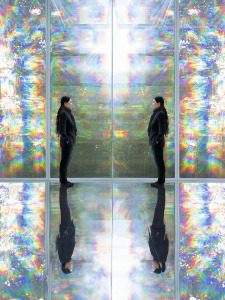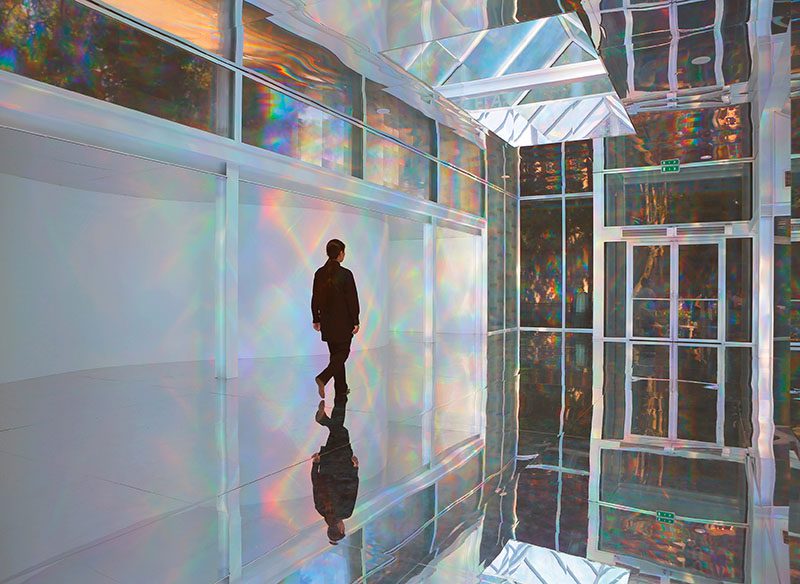ART-PRESENTATION: Kimsooja-To Breath
 Kimsooja’s videos and installations blur the boundaries between aesthetics and transcendent experience through their use of repetitive actions, meditative practices, and serial forms. In many pieces, everyday actions, such as: sewing or doing laundry, become two- and three-dimensional or performative activities. Central to her work is the “Bottari,” a traditional Korean bed cover used to wrap and protect personal belongings, which Kimsooja transforms into a philosophical metaphor for structure and connection. In videos that feature her in various personas: Needle Woman, Beggar Woman or Homeless Woman, she leads us to reflect on the human condition, offering open-ended perspectives through which she presents and questions reality. Kimsooja’s works emphasize metaphysical changes within the artist-as-performer as well as the viewer.
Kimsooja’s videos and installations blur the boundaries between aesthetics and transcendent experience through their use of repetitive actions, meditative practices, and serial forms. In many pieces, everyday actions, such as: sewing or doing laundry, become two- and three-dimensional or performative activities. Central to her work is the “Bottari,” a traditional Korean bed cover used to wrap and protect personal belongings, which Kimsooja transforms into a philosophical metaphor for structure and connection. In videos that feature her in various personas: Needle Woman, Beggar Woman or Homeless Woman, she leads us to reflect on the human condition, offering open-ended perspectives through which she presents and questions reality. Kimsooja’s works emphasize metaphysical changes within the artist-as-performer as well as the viewer.
By Efi Michalarou
Photo: Centre Pompidou-Metz Archive
The latest installation of Kimsooja’s “To Breath” at the Centre Pompidou-Metz seeks to be the sum of the artist’s early meditation on painting, where the surface of the canvas is intuited to become a mirror that wraps identity, space and time; and where brushstrokes are destined to dematerialize into a splitting of light. For this exhibition Kimsooja takes on the spaces of Centre Pompidou-Metz’s architecture to create a tri-dimensional tableau that transforms the long span of the museum’s Gallery 2 and its bay windows into a liquid-like mirrored surface. Light is diffracted into an iridescent color spectrum on the surface of its windows before reuniting inside the projection of the artist’s video “To Breathe: Invisible Mirror, Invisible Needle”, a sequence of digital monochromatic color fields projected against an expanse of mirrored floor accompanied by the sound of “The Weaving Factory”. In 2006 the artist noted in an interview: “For me, making space means creating a different space, rather than making a new one. The space is always there in a certain form and fluidity, which can be transformed into a completely different substance (…) My interest in void lies in the relationship between Yin and Yang, as a way of inhaling and exhaling, which is the natural process of breathing, as a law of living”. Thinking of mirrors as an opportunity to fold and unfold spaces (a continuation of the artist’s involvement with the Korean tradition of wrapping belongings into travel bundles known as Bottari in Korean), Kimsooja first made use of a mirrors at the 48th Venice Biennale curated by Harald Szeemann, where she reflected the “Bottari Truck in Exile” onto a wall sized mirror that provided a virtual exit for the vehicle. She further explored infinite spaces by installing mirrors on the walls of a laundry installation of abandoned Korean bedcovers for “A Mirror Woman”, and pointed to the migratory perspective opened by mirrors while reflecting the sky on the ground of her mirrored installation “The Ground to Nowhere”. Kimsooja enveloped the transparent structure of the Palacio de Cristal in Madrid with mirrors and diffraction films for “To Breathe: A Mirror Woman”, and of the Korean Pavilion in 55th Venice Biennale, curated by Massimiliano Gioni, she presended “To Breathe: Bottari”, that invited the audience into a journey inside and outside of themselves, and into a poetic space where our perception of light, color and orientation is deconstructed and exposed as an unfolding plane.
Info: Centre Pompidou-Metz, 1 Parvis des Droits de l’Homme, Metz, Duration: 26/10/15-4/1/16, Days & Hours: Wed-Mon 10:00-18:00, www.centrepompidou-metz.fr


